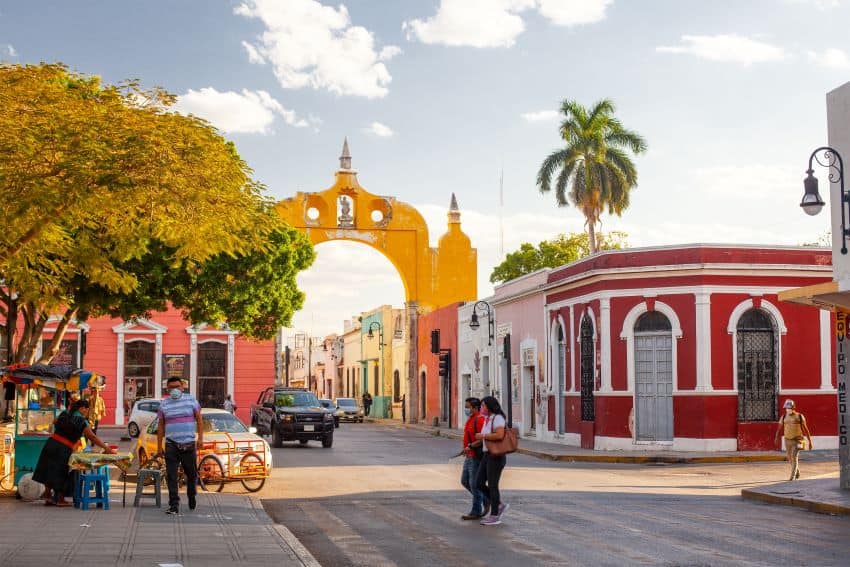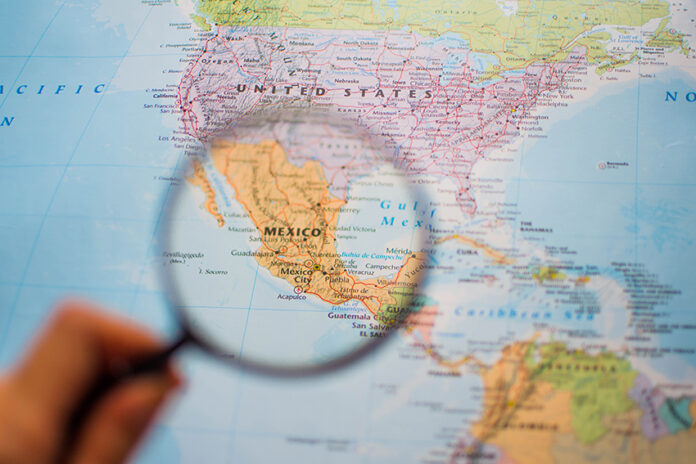Given the constant flow of news on both sides of the border, I wanted to get an update on people’s interest in moving to Mexico and if it is changing. Are gentrification protests and a strong peso scaring people from coming? Are political and social tensions pushing more people to consider moving? I sat down with Mariana Lange of Mexico Relocation Guide to learn first hand what her team is seeing. The following is my recent interview with her.
Travis Bembenek: Tell us about what you do. How long you have been doing it?
Mariana Lange: Hola! My name is Mariana Lange, and I run Mexico Relocation Guide, a website and service dedicated to helping people move to Mexico the right way. I’ve been doing this since 2019, and have since then helped thousands of people move to Mexico with less stress. We provide a comprehensive online guide. Think of it like an “everything moving to Mexico course” that walks you through the most important steps. I cover everything from visa requirements and healthcare to finding rentals, buying a car, bringing pets and a lot more.

Of course there was a huge wave of people looking to live in Mexico during the pandemic. What have you seen since then?
During the pandemic, many people had a reality check, and their priorities changed. They wanted a better quality of life, more freedom, a lower cost of living, and less of the constant doom and gloom they are exposed to in the U.S. and Canada. So, yes, Mexico became a very attractive option.
Since then, the demand hasn’t slowed down. In fact, every year we get more and more people emailing us, contacting me, and commenting on my videos. They all have one thing in common: They are very interested in learning more about the possibility of moving to Mexico. Now, people are doing deeper research, spending more time visiting first, and often working remotely while they test out different cities. It’s no longer just a temporary escape, it’s a long-term plan.
Tell us about the people you are seeing looking to relocate. Where are they from? Are they retired? Still working? How are they different from in the past?
I still work with a lot of retirees especially from the U.S. and Canada, but there’s been a huge increase in younger, remote-working professionals and early retirees. I have clients in their 40s and 50s who want to enjoy life now instead of waiting until 65.
I’ve also received a considerable number of clients who have roots in Mexico that they want to reconnect with, but they just don’t know how the process works.
What’s changed is their mindset. They’re not just looking for beaches and margaritas. They want community, a beautiful city, walkability, good healthcare, safety, friendly people and/or financial freedom. They’re also more conscious about respecting the local culture and integrating into their new environment. Most of my clients are taking Spanish lessons, reading books on Mexican history and culture, volunteering with local charities, and genuinely wanting to integrate into society.
Let’s talk about where people are looking to retire in Mexico. Is it still beaches? Or do you see a trend to cities? What are the hot spots now?
Definitely, beaches are still popular — Puerto Vallarta, Mazatlán, Playa del Carmen, Cabo — but we’re definitely seeing more interest in interior cities like Mérida, San Miguel de Allende, Puebla, Querétaro, and even smaller towns like Chapala, Cuernavaca, Atlixco or Valle de Bravo.
Many are looking for better infrastructure, a lower risk of hurricanes and more authentic Mexican culture. Big cities like Mexico City, Guadalajara and Monterrey are attracting people who want to live in a modern city that has a bit of everything, like excellent medical care and international airports. But honestly, I have clients living everywhere in Mexico — even smaller towns I had never heard of. People are learning that Mexico is huge, and that there are hundreds of cities and towns that they are interested in scouting.
That’s why our directory of contacts is so popular. Because I have clients who, for example, thought they wanted to live on the beach, but then realized they can’t handle the heat. And maybe Guanajuato has caught their eye because it has cooler weather year-round, but isn’t a huge city. With our directory of vetted contacts, they can easily find the right people to help them with a local relocation tour, or find a rental, move their things, move their pets, open a bank account, etc. I also have clients who thought they really wanted to live in Lake Chapala. But after a year, they decided another town would be a better fit for their lifestyle.

Do you find that the questions people are asking are different than before? Do they care more about culture, integration with Mexicans, etc.?
Absolutely! In the past, the first questions were usually about the cost of living and visas. Now, I hear more people asking:
- How can I volunteer? Where can I volunteer?
- What are some things I shouldn’t do to avoid upsetting the locals?
- Is it easy to make Mexican friends?
- What’s the etiquette I should know before I move?
That’s a great sign. People want to be good neighbors, not just tourists with long-term visas. They care more about learning Spanish, getting involved locally, not only making friends with other foreigners, but also being respectful of Mexican customs and values.
Have you heard from anyone that they are afraid of the way they will be treated in Mexico given the way that the Trump administration is treating some Mexican immigrants in the U.S.?
Yeah, it does come up. Some Americans feel embarrassed or nervous about how they’ll be received in Mexico because of the political climate in the U.S., especially after seeing the news that a group of people were marching against foreigners living in Mexico.
But what I always tell them is: Mexicans are incredibly welcoming, especially when you come with humility, curiosity and respect. Most people here can separate politics from individuals as long as you’re not showing up entitled or expecting everything to be “like back home,” you’ll be treated kindly and with warmth.
There have been anti-gentrification protests in CDMX recently in the news. Do people ask you about that? How do you respond?
Yes, people ask for my opinion about the protest all the time. And here’s what I have said in the past. The key thing I explain is this: gentrification is real, and we need to be aware of our impact. CDMX, especially neighborhoods like Roma and Condesa, have seen major price hikes recently. But also, these neighborhoods have ALWAYS been expensive, and Mexico City is a lot more than just three trendy neighborhoods. Now, at the same time, I always give people realistic cost of living examples across Mexico in our free newsletter, so they know what the real cost of things is. That way, a few greedy landlords don’t end up overcharging them, just because they are seen as having more money, because they come with dollars. We can’t solve gentrification overnight, but we can move responsibly and mindfully.
Another side of the story: A Mexican perspective on gentrification
I have read that the residency requirements for immigrants here are changing. Is that true? What can you tell us?
Yes, the overall formulas used to calculate economic solvency are changing. The actual amounts aren’t going to change drastically from 2025 to 2026, but there are some good changes coming down the pipeline. Even though the solvency requirements from 2025 to 2026 won’t change that much, the new formulas will prevent economic solvency requirements from increasing as much from one year to another as they have in the past. I wrote an entire blog post explaining what the changes are and when people can expect to see them roll out.
What are the biggest reasons you hear from people when they tell you they are considering relocating to Mexico?
Most of my clients’ main reason for moving to Mexico is the lower cost of living. But they could also easily lower their cost of living by moving to other countries. They choose Mexico because of its diversity: They can easily visit beaches, mountain towns, big cities or small pueblos mágicos. They also like its proximity to friends and family, if they come from Canada and the U.S. Many are tired of expensive or limited healthcare back home. I also have a lot of clients who are excited about a slower pace and a more meaningful lifestyle. They have heard that Mexico’s culture is family-oriented, and they miss that kind of connection in the U.S. or Canada. They feel lonely, and they are excited about the idea of making new friends and reinventing themselves!
There’s also a fair number of clients who love the freedom now that they can work from anywhere, and they choose Mexico because of a combination of all of the above.
Ultimately, it’s about quality of life. People are realizing they can have a better, richer life here, often for a fraction of the cost, which gives them either the ability to retire sooner or have a bit more peace of mind to not run out of money.
I recently wrote that I think there is a strong argument that Mexico needs more Americans and Canadians, not less. Currently, there are an estimated 1.6 million Americans and 400,000 Canadians living in the country. If you had to predict where the numbers could be in 5 and 10 years, what would you predict?
That’s a hard one, because I am not an expert in migration or socio-economics to give you an educated answer. But if I’m just spitballing, in the next 5 years, I wouldn’t be surprised if we saw 2.5 to 3 million combined American and Canadian residents living in Mexico, especially as more baby boomers retire and the cost of living continues to increase as much as it has north of the border.
In 10 years? I could easily see 4 million or way more, especially if remote work continues to normalize, the residency visa requirements are pretty stable, and if more people realize they don’t need to wait for retirement to move abroad.
But again, I’ll always emphasize: numbers are one thing, how we integrate and contribute is what really matters.
What separates you from other companies providing similar services in this space?
What sets us apart is that I am consistently updating our online guide to reflect current laws and practices. And also, that we have the only directory of vetted, trusted contacts across Mexico. I have a complete directory of the best immigration facilitators, realtors, healthcare advisors, moving companies, local concierges and more. We also have private relocation tours in over 50 cities across Mexico — with NO agenda to sell you any real estate. If you would like us to help you, you can find us here: https://mexicorelocationguide.com/.
Travis Bembenek is the CEO of Mexico News Daily and has been living, working or playing in Mexico for nearly 30 years.
